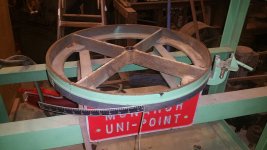ironhoarder
Cast Iron
- Joined
- Oct 9, 2005
- Location
- Waterford, VA USA
These are pics of the pivot base of a huge woodworking radial arm saw (Monarch Uni-Point) that fell over and suffered damage.
This ring needs to be dead flat, and the center pivot point must be cylindrical with no bumps. I figure I'll take this ring to a local welding guy who is also a machinist' I'm thinking he'll appreciate the need for precision on this repair. I could attempt myself perhaps, but this calls for expert I think.
I'd like opinions on how successful this repair is likely to be, and what technique you would suggest. The primary candidates being brazing or welding with nickel rod. Maybe even silver soldering? It seems to me that one would need to clamp the work to a good flat surface to keep it in alignment, and do plenty of even pre-post heating.
Whatever technique is used, I'll need to be able to grind/file the repair down flush with the adjacent surfaces- particularly in the center pivot point, and along the top edge, where the large round base rides.




 View attachment 268300
View attachment 268300
This ring needs to be dead flat, and the center pivot point must be cylindrical with no bumps. I figure I'll take this ring to a local welding guy who is also a machinist' I'm thinking he'll appreciate the need for precision on this repair. I could attempt myself perhaps, but this calls for expert I think.
I'd like opinions on how successful this repair is likely to be, and what technique you would suggest. The primary candidates being brazing or welding with nickel rod. Maybe even silver soldering? It seems to me that one would need to clamp the work to a good flat surface to keep it in alignment, and do plenty of even pre-post heating.
Whatever technique is used, I'll need to be able to grind/file the repair down flush with the adjacent surfaces- particularly in the center pivot point, and along the top edge, where the large round base rides.




 View attachment 268300
View attachment 268300
Last edited:





